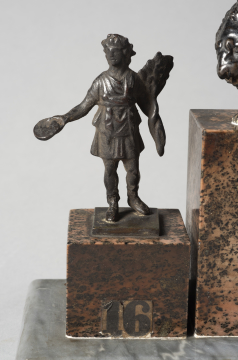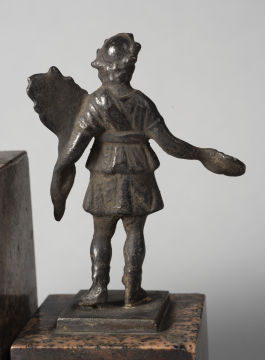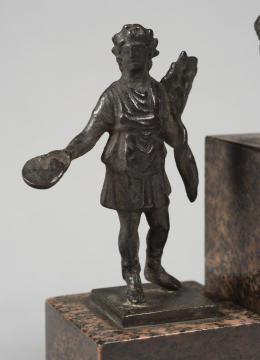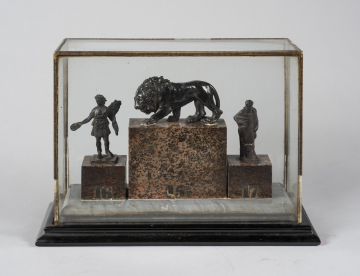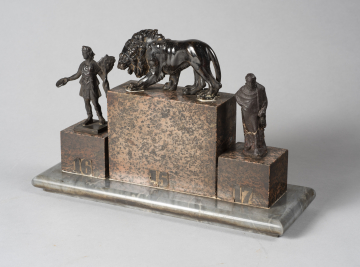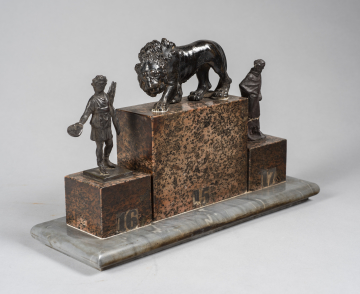Explore Collections


You are here:
CollectionsOnline
/
Roman statuette of a Lar (household god)
Browse
Roman statuette, SM BR16. ©Sir John Soane's Museum, London. Photo: Art UK
Roman statuette of a Lar (household god)
Bronze, cast solid
Height: 7.5cm
Width: 3cm
Depth: 3cm
Height (plinth): 4cm
Width (plinth): 5cm
Depth (plinth): 5cm
Width: 3cm
Depth: 3cm
Height (plinth): 4cm
Width (plinth): 5cm
Depth (plinth): 5cm
Museum number: BR16
On display: Breakfast Room
All spaces are in No. 13 Lincoln's Inn Fields unless identified as in No. 12, Soane's first house.
For tours https://www.soane.org/your-visit
Curatorial note
A Lar, standing with wreathed head turned to the right, clad in a chiton with a long overfold and a high girdle, sandals on his feet. In his extended right hand he holds a patera, in the left a large cornucopia-like branch of bay.
The many figures of this and allied types in collections of Roman bronzes testify to their popularity, probably as household shrine statues, throughout the Roman world, particularly in the West. Dr. Bieber1 discusses the type and notes the appearance of these figures on altars, such as on the secondary sides of the altar consecrated in 2 B.C. in the Palazzo dei Conservatori2. Little bay trees appear often on Lar Altars (see for example altars in the Vatican, Lateran, and one formerly in the Antiquario Communale in Rome3 and in Florence4. More broadly the bay is associated with the cult of Apollo which Augustus and his successors especially cultivated. For a discussion of monuments connected with the cult of the Lares in the early Imperial period, see the good general summary by E. Strong5. There are several similar similar bronze statuettes of this type of Lar in the British Museum6.
1 Cassel, p. 69, no. 209, pl. XLIII.
2 Jones, Cons., p. 74f., no. 2, pl. 26; Altmann, RGK, pp. 176-177, no. 232, fig. 141a, etc.
3 Helbig, Führer, nos.155, 1040, and 1177.
4 Amelung, Führer, no. 99.
5 E. Strong, Art in Ancient Rome, 1, Altars of Lares, pp. 143-144; see also Roscher, Lex., II, 2, "Lares" and Zanker, Augustus.
6 BMC, Bronzes, LAR FAMILIARIS, nos. 1562-1580.
The many figures of this and allied types in collections of Roman bronzes testify to their popularity, probably as household shrine statues, throughout the Roman world, particularly in the West. Dr. Bieber1 discusses the type and notes the appearance of these figures on altars, such as on the secondary sides of the altar consecrated in 2 B.C. in the Palazzo dei Conservatori2. Little bay trees appear often on Lar Altars (see for example altars in the Vatican, Lateran, and one formerly in the Antiquario Communale in Rome3 and in Florence4. More broadly the bay is associated with the cult of Apollo which Augustus and his successors especially cultivated. For a discussion of monuments connected with the cult of the Lares in the early Imperial period, see the good general summary by E. Strong5. There are several similar similar bronze statuettes of this type of Lar in the British Museum6.
1 Cassel, p. 69, no. 209, pl. XLIII.
2 Jones, Cons., p. 74f., no. 2, pl. 26; Altmann, RGK, pp. 176-177, no. 232, fig. 141a, etc.
3 Helbig, Führer, nos.155, 1040, and 1177.
4 Amelung, Führer, no. 99.
5 E. Strong, Art in Ancient Rome, 1, Altars of Lares, pp. 143-144; see also Roscher, Lex., II, 2, "Lares" and Zanker, Augustus.
6 BMC, Bronzes, LAR FAMILIARIS, nos. 1562-1580.
From the collection of John Flaxman.
Soane collections online is being continually updated. If you wish to find out more or if you have any further information about this object please contact us: worksofart@soane.org.uk
